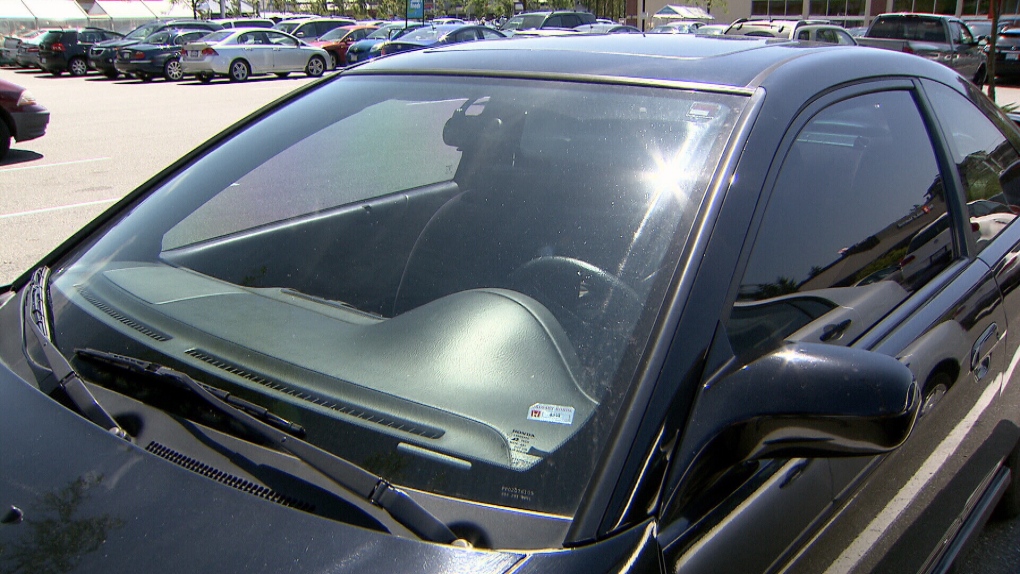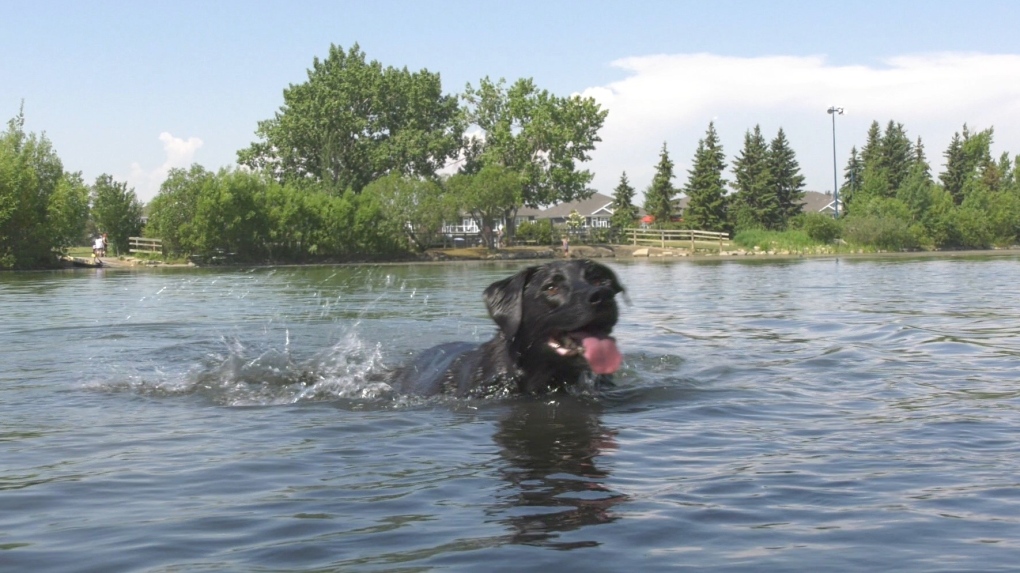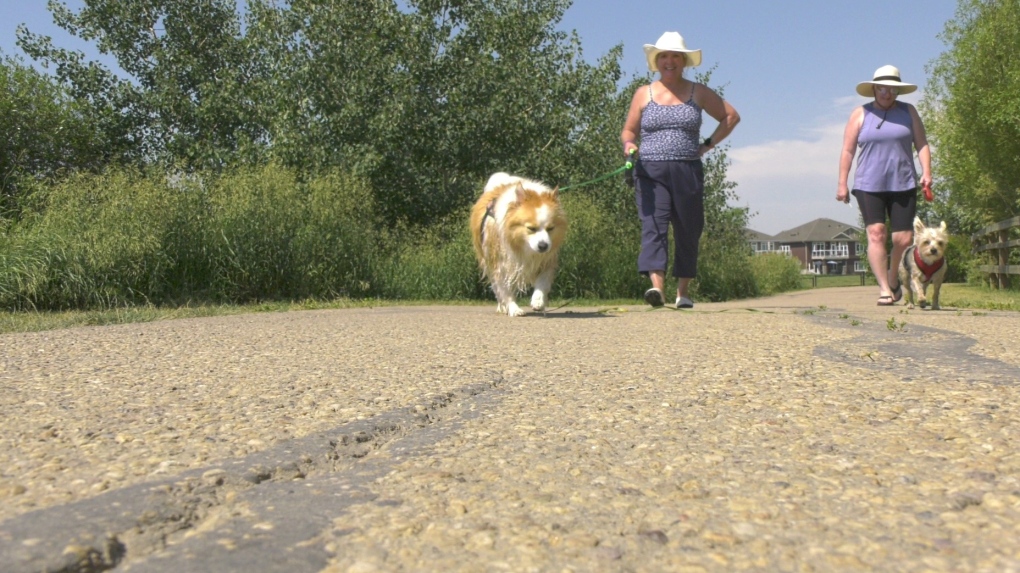'That animal is in danger of dying': How to protect pets from summer heat
As many parts of Alberta are setting temperature records, officials are reminding people that pets need protection from the heat too.
"Animals can't regulate their body temperatures in the same ways that we can," said John Wilson, director of animal control and park rangers in Edmonton.
"They are actually quite vulnerable, regardless of breed, to heat exhaustion, to heat stroke and unfortunately even to death if they're exposed to very high, excessive heat for long periods of time," he said.
Still, Wilson said people thinking it's OK to leave pets in vehicles during the summer continues to be a problem.
From May to July of this year, animal care and control officers responded to 49 complaints of dogs left in vehicles, while Edmonton Fire Rescue has been called at least 24 times in July alone.
 Sun beams down on a car in this undated file photo.
Sun beams down on a car in this undated file photo.
"Temperatures inside vehicles can skyrocket very quickly and that is incredibly dangerous for animals," Wilson said.
When the temperature outside is 32 C it only takes about 10 minutes for that temperature to climb to 43 C inside a vehicle.
 Data from the City of Edmonton shows how hot the inside of a vehicle can get after 10 minutes based on the outside temperature. (CTV News Edmonton)
Data from the City of Edmonton shows how hot the inside of a vehicle can get after 10 minutes based on the outside temperature. (CTV News Edmonton)
"I think sometimes people integrate their pets into their lifestyle and they just like to take their pets with them," said Wilson.
"The fact is the safest option is to leave your pet at home," he added.
Signs an animal are in distress from the heat include things like excessive and rapid panting.
"They're weak or non-responsive. Sometimes when an animal has heat stroke or is starting to get sick it will lose consciousness. Sometimes it may even vomit or have diarrhea," Wilson said.
Pets are at risk of the same symptoms when left outside in the heat for too long as well.
Wilson said pet owners should make sure there's plenty of drinking water and shade available. A wading pool can also provide a way for your pets to cool down.
"Get their feet wet. Some people what they'll do is they'll spray their animals with water and then make sure there's a fan because that can help the water evaporate and cool them down quickly," he said.
 A St. Albert resident plays fetch with his dog at Lacombe Lake Dog Park. (Amanda Anderson/CTV News Edmonton)
A St. Albert resident plays fetch with his dog at Lacombe Lake Dog Park. (Amanda Anderson/CTV News Edmonton)
Several dog owners helped their dogs beat the heat on Wednesday with a trip to the Lacombe Lake Dog Park in St. Albert.
Stewart said his 11-year-old dog Dez would spend hours playing in the lake if allowed.
"I want to make sure he stays cool and it's nice that he has fun too," he said.
 An 11-year-old dog named Dez swims at Lacombe Lake Dog Park in St. Albert. (Amanda Anderson/CTV News Edmonton)
An 11-year-old dog named Dez swims at Lacombe Lake Dog Park in St. Albert. (Amanda Anderson/CTV News Edmonton)
"I do have some portable air conditioners in the house and I leave it running for him just because he's getting older," he added.
During this extreme heat many dog owners have also found themselves changing daily schedules to get walks in.
"Our first walk is, we get up at 5 a.m.," Stewart said, adding "We go back to sleep for awhile but we get up at 5 a.m. and he has a little tiny walk."
"We usually go out in the morning, go around the building and then we come here for a swim, back in the car and then we wait until eight, nine at night till it cools off and then we go for a long walk," said another dog owner Carol Champagne.
Many are also opting for routes that have a lot of shade.
 Two St. Albert residents walking their dogs at Lacombe Lake Dog Park. (Amanda Anderson/CTV News Edmonton)
Two St. Albert residents walking their dogs at Lacombe Lake Dog Park. (Amanda Anderson/CTV News Edmonton)
Wilson said pet owners also need to remember the pavement can get so hot under the summer sun it could burn the pads on a dog's paws.
"If you have to walk them when the pavement is hotter and there isn't for example grass to walk on, I encourage people to consider using boots much like we do in winter," he said.
"You can use those same boots in summer to actually protect the bottom of their feet when they're out on the hot pavement," Wilson added.
If you recognize signs of heat distress in your own animal Wilson said you should contact your veterinarian immediately.
If you spot an animal in distress he said to call 9-1-1.
"We take this very seriously because that animal is in danger of dying if there is no owner around, no one you can immediately contact," said Wilson.
"We also ask people to call 3-1-1 and animal control peace officers will be dispatched. We don't encourage people to damage private property, what we do ask is that they contact us immediately," he added.
Wilson said minutes matter when an animal is left in a car.
"They can't call themselves so it's important we act quickly."
CTVNews.ca Top Stories

Bird flu, measles top 2025 concerns for Canada's chief public health officer
As we enter 2025, Dr. Theresa Tam has her eye on H5N1 bird flu, an emerging virus that had its first human case in Canada this year.
Ottawa police identify victim of Christmas Day homicide in Hintonburg, charge suspect
The Ottawa Police Service says the victim who has been killed on Christmas Day in Hintonburg has been identified.
Christmas shooting at Phoenix airport leaves 3 people wounded
Police are investigating a Christmas shooting at Sky Harbor Airport in Phoenix that left three people injured by gunfire.
Your kid is spending too much time on their phone. Here's what to do about it
Wondering what your teen is up to when you're not around? They are likely on YouTube, TikTok, Instagram or Snapchat, according to a new report.
Plush toys recalled due to choking hazard
Health Canada announced a recall on a series of plush toys due to a choking hazard. Anyone who has purchased an elephant, giraffe, lion, tiger and/or panda plush toy with an attached baby can return them to the place of purchase for a refund.
6,000 inmates stage Christmas Day escape from high-security Mozambique prison
At least 6,000 inmates escaped from a high-security prison in Mozambique's capital on Christmas Day after a rebellion, the country's police chief said, as widespread post-election riots and violence continue to engulf the country.
Azerbaijan observes day of mourning for air crash victims as speculation mount about its cause
Azerbaijan on Thursday observed a nationwide day of mourning for the victims of the plane crash that killed 38 people and left all 29 survivors injured as speculation mounted about a possible cause of the disaster, with some experts saying that the airliner was damaged by Russian air defence fire.
Donald Trump says he urged Wayne Gretzky to run for prime minister in Christmas visit
U.S. president-elect Donald Trump says he told Canadian hockey legend Wayne Gretzky he should run for prime minister during a Christmas visit but adds that the athlete declined interest in politics.
Prayers and tears mark 20 years since the Indian Ocean tsunami that killed some 230,000 people
People gathered in prayer and visited mass graves in Indonesia’s Aceh province on Thursday to mark 20 years since the massive Indian Ocean tsunami hit the region in one of modern history’s worst natural disasters.




























